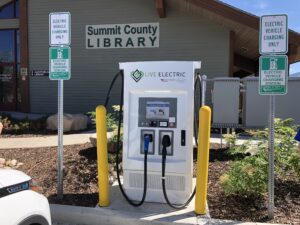 On February 15, 2023, the White House, Department of Transportation (DOT), Department of Energy (DOE), Joint Office, and Federal Highway Administration (FHWA) made major announcements that are collectively enabling the build-out of a nationwide network of EV charging stations. Most importantly, the DOT and FHWA released comprehensive standards for electric vehicle (EV) charging infrastructure funded under Title 23 programs, which includes the National Electric Vehicle Infrastructure (NEVI) program.
On February 15, 2023, the White House, Department of Transportation (DOT), Department of Energy (DOE), Joint Office, and Federal Highway Administration (FHWA) made major announcements that are collectively enabling the build-out of a nationwide network of EV charging stations. Most importantly, the DOT and FHWA released comprehensive standards for electric vehicle (EV) charging infrastructure funded under Title 23 programs, which includes the National Electric Vehicle Infrastructure (NEVI) program.
Find the EC’s top 10 takeaways from FHWA’s standards below. The EC commends those who worked on the standards and is excited to work with communities on the ground to implement them efficiently, effectively, and equitably. Please note that the following list is not a comprehensive overview of the rule—more information on the minimum standards can be found on FHWA’s website.
- Beyond NEVI: These standards are inclusive of the NEVI program, the Charging and Fueling Infrastructure (CFI) grant program, and other public charging stations along the Alternative Fueled Corridors (AFCs). These standards will shape that nation’s public EV charging network and are representative of unprecedented investment in transportation electrification.
- Charging speeds: AFC charging stations must be composed of four DC fast charging (DCFC) chargers that can charge four cars simultaneously at 150 kW. Non-AFC stations can be Level 2 stations, DCFC stations, or a combination of the two.
- Buy America: Final assembly and all manufacturing process must occur in the United States. By July 2024, at least 55% of the cost of all components must be manufactured domestically. Read more about the Buy America requirements here.
- Payment and fees: At a minimum, stations must have contactless payment methods that accept major credit cards as well as a helpline. Charging stations are not allowed to have membership fees.
- Uptime: Stations are required to have an uptime of 97%. The standards indicate “a charging port is considered ‘up’ when its hardware and software are both online and available for use, or in use, and the charging port successfully dispenses electricity in accordance with requirements for minimum power level.”
- Operations and maintenance: Five years of operation and maintenance remains the minimum coverage for stations. Charger installation and maintenance must be performed by technicians who are EVITP-certified or hold equivalent state-based apprenticeship certification.
- Real-time data: Data sharing is required free of charge, allowing third-party apps access to real-time data on charging stations.
- Vehicle-to-grid technology (V2G): While V2G technology is not required in charging stations, purchasing, installing, and operating the technology are eligible uses of funding.
- Americans with Disabilities Act (ADA) compliance: ADA compliance is required in stations allowing more Americans to access and utilize charging stations.
- Minimums: The standards provide a floor, not a ceiling, for what public charging stations can look like. States can use funding to exceed standards in a variety of ways, including but not limited to increasing operation and maintenance timelines, installing V2G technology, allowing stations to adapt to medium and heavy-duty vehicles, and adding additional stations.
Looking for additional funding pathways for transportation electrification (TE) projects? Check out the EC’s EV Funding Finder—a tool that helps eligible recipients sort through available federal funds for TE and helps recipients understand how investments can be matched. It can also help users identify where technical assistance is available.
